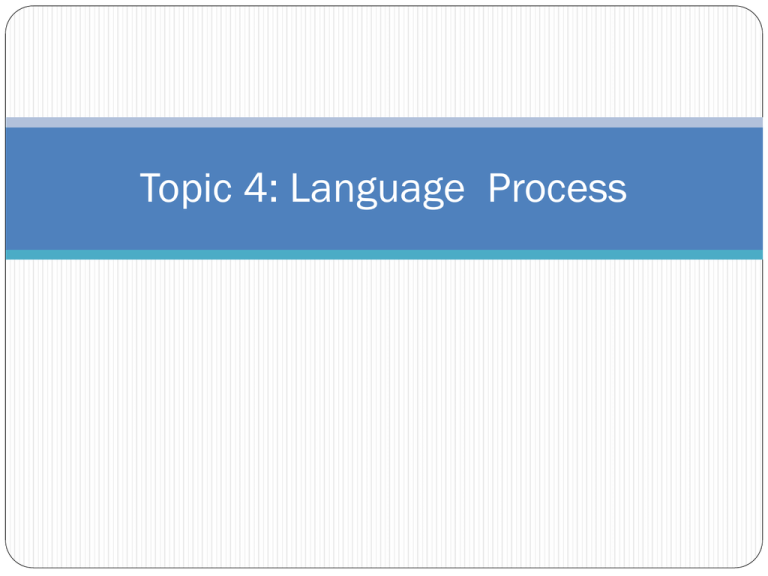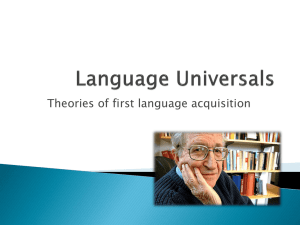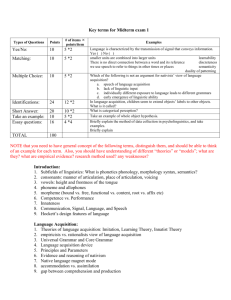What is Language Acquisition? - UPM EduTrain Interactive Learning
advertisement

Topic 4: Language Process Language Process Human language is unique, complex and flexible: making us (human) more superior than other species form of communication. distinguishes us from other animals. The use of language in human reflects: our mental behavior our cognitive ability Language & Thinking are closely related. Language Development is important because: Through language children interact Language development very much related to intellectual development Through language children are able to progress in other developmental domain. What is Language? Language can be defined in many ways. Language is…… “a set of (finite and infinate) sentences. Each is finite in length and constructed out of a finite set of elements” (chomsky, 1957) “a mean of communication, generally through spoken sounds that express specific meanings, and are arranged according to rules”. (Papalia & Olds, 1985) “an organized system of symbols with meanings that are shared, and are used to communicate”. (Bourne & Mamcy Felipe Russo, 1998) What is Language? A law of grammar and semantic that makes conversation more meaningful , i.e. language is a combination of words to communicate a symbolic code used in communication. A collection of symbols with rules and collectively they can create an infinite variety of messages i.e. a system of symbols and rules that enable us to communicate. The systematic, meaningful arrangement of symbols according to rules to create a message that has a common meaning for users and recipients. Covers ways of communication where thoughts and emotions are being expressed in order to convey message/meaning to others 6 1. 2. 3. 4. 5. 6. Properties of language Communicative – enable people to communicate with each other. Arbitrarily symbolic - Language create an arbitrary relationship between a symbol and its reference, such as things, ideas, process, relationship & description. Regularly structured - Language has a structure, where particular patterns of sounds and letters form meaningful words. Structured at multiple levels – Language structure can be analyzed at more than one level (e.g. in sound, meaning units, words, phrases etc) Generative, Productive – Limitless ability to produce language creatively Dynamic – Language constantly evolves LANGUAGE ACQUISITION What is Language Acquisition? A process where one learns language learning a native language (first language) or a second language. The process of attaining a specific variant of human language. Learning language occurs throughout an individual’s life span it progress according to individual developmental stages Language Acquisition, Representation, & Processing Language acquisition How is language acquired or learned? Language representation How are the symbols of language represented in memory? Language processing What factors influence the processing of language? How are Language Acquisition, Representation, & Processing Related? How are Language Acquisition, Representation, & Processing Related? Language is acquired How are Language Acquisition, Representation, & Processing Related? Language is acquired Acquisition leads to a set of representations How are Language Acquisition, Representation, & Processing Related? Language is acquired Acquisition leads to a set of representations Language use is the processing of these representations Language Acquisition Two types of Language acquisition: First language acquisition Infants’ acquisition of their native language Second language acquisition Additional languages children & adult. learned (acquired) by Language Acquisition: First language acquisition How do we learn our native language? What are the stages this process follows? How do failures in this process occur? When you’re tired--not just people with pathologies Language Acquisition: Language Development Phonological development —from babbling to full sentences Semantic development We learn what things mean (semantics) and acquire concepts Syntactic development and syntactic categories We learn the syntax of our language (what are syntactic categories) Stages of Language Acquisition Receptive language (language comprehension) Productive language (language expression or speaking) Cooing (6-8 mths) – mostly vowels sound (aaaa, uuuuu, oooo….) Babbling (9-18 mths) – comprising of consonant and vowel sounds (BA, MA…) One-word utterance - (18-24 mths) – limited in both vowels & consonant – single word (BALL, DAD, HIT….) Two-word utterance and telegraphic speech (24-30 mths) - simple sentence (BAD DOG…). Basic adult sentence structure (above 30 mths) – building sentence – presence of grammatical and functional structure, and continuing vocabulary acquisition. Language Acquisition Second Language Acquisition Factors that affect our chances of learning L2: Individual differences working memory span Age of acquisition effects time at which begin to learn L2 Environment of learningc classroom versus immersion arnab is “rabbit” or associations between translations or directly to concepts Style of instruction– Speech Perception What is Speech Perception? Speech Perception is the process by which the sounds of language are heard, interpreted and understood, i.e. in order for people to communicate with other people, they must first understand what is being spoken to them. Speech Perceptions refers to the process by which human are able to interpret and understand the sounds used in language. The study of speech perception is closely linked to the fields of phonetics & phonology (in linguistics) and cognitive & perception (in psychology) Research in speech perception seeks to understand how human listeners recognize speech sounds and use this information to understand spoken language. Speech Perception Basically children (human) need to learn four kinds of knowledge about language: Phonology sound system of language Semantics the meaning conveyed by words and sentences Syntax The set of grammatical rules indicating how words may be combined to make sentences Pragmatics The priciple that determine how language are used pragmatically - according to situations & modified to fit the context (e.g: we speak in a simpler manner to a child than to an adult) Phonological development Understanding & pronouncing words Vocabulary Fast mappingabsorb the meaning of a new word after hearing it only once or twice in conversation The use of metaphor, a figure of speech in which a word or phrase that usually designates one thing is applied to another, becomes increasingly common A child learn to pronounce through imitation (repetitive) Eg. TV (ivi), Susu (cu), Minum (num), tumpah (pah) A deaf child normally have problem in speaking Semantic development A child learn the meaning of words then combine the words Adik + Nak + Susu A child will then try to relate the meaning of certain words with it’s sound. Addition to his/her vocabulary. Grammar development Children learn about grammar add words to make simple sentences. 2 phase: The development of simple sentences from basic words. The development of complex sentences Children start asking questions thinking & understanding process is very rapid. Intelligent children use complex and sophisticated sentences/words As age increases familiarity with words and sentences increases able to use, different form of sentences. Pragmatic development Children learn about the aim and how certain words and sentences are being used in a conversation use language efficiently in social context. Pragmatics the practical knowledge of how to use language to communicate. Social speech Speech intended to be understood by a listener Private Speech Talking aloud to oneself with no intent to communicate with others Normal and common in childhood Noam Chomsky Theory of Language Acquisition Device (LAD) Children (human) will automatically acquire language merely by being exposed to it, regardless of any external reinforcement or operant conditioning. Children (human) have an innate language acquisition device (LAD) i.e. an inbuilt mechanism which automatically allows a child to decode and spoken language she/he hears According to Chomsky, languages differ only in the surface structure, but they share a similar underlying deep structure, i.e. the fundamental meaning and actions that the words convey (“Ahmad eat banana” = “ The banana was eaten by Ahmad”) – eventhough their surface structure is different, but they have same deep structure (meaning of sentence/word). The classical Wernicke-Geschwind model of language Wernicke–Geschwind model Carl Wernicke created an early neurological model of language, that later was revived by Norman Geschwind - The model is known as the WERNICKE–GESCHWIND MODEL. According to Wernicke, people who suffer from brain damage to a particular part of the brain (i.e. temporal lobe – Wernicke’s area) may experience receptive aphasia, i.e. cannot understand speech, but still can speak fluently (their speech is meaningless). Damage to Broca’s area (frontal cortex) cause individual to suffer from aphasia, i.e. cannot speak (partial/total loss of speech ability) but still understand what others are saying. Wernicke–Geschwind model W-G model suggest that wernicke’s area contains auditory codes (i.e. information about what they SOUND like and meaning of words), and Broca’s area consists of articulatory codes (the motor commands that tells the mouth & larynx how to form words. For listening to and understanding spoken words, the sounds of the words are sent through the auditory pathways to area 41 (the primary auditory cortex) From here they continue to wernicke’s, where the meaning of the words is extracted. In order to speak, the meanings of words are sent from Wernicke’s area via the arcuate fasciculus to Broca’s area. Broca’s area holds a representation for articulating words Instructions for speech are sent from Broca’s area to the facial area of the motor cortex and from there instructions are sent to facial motor neurons in the brainstem, which relay movement orders to facial muscles. Wernicke– Geschwind Model Wernicke–Geschwind model In order to READ, information concerning the written text is sent from visual areas 17, 18, and 19 to the angular gyrus (area 39) and from there to Wernicke’s area (for silent reading) or, together with Broca’s area (for reading out loud). This model is now obsolete. But it has been very useful in directing research and organizing research results, because it is based on the idea that language consists of two basic functions: comprehension (a sensory/perceptual function) Speaking (a motor function.) SCL Questions to discuss 1. In your opinion…. Can one language ever be fully turned off? Is L1 grammar always active? Can L2 become the more dominant language? What factors influence the relative activation of the two languages (individual and contextual)? 2. Discuss: Noam Chomsky Theory of Language Acquisition Device (LAD) Wernicke-Geschwind model. The differences in both theory/model







